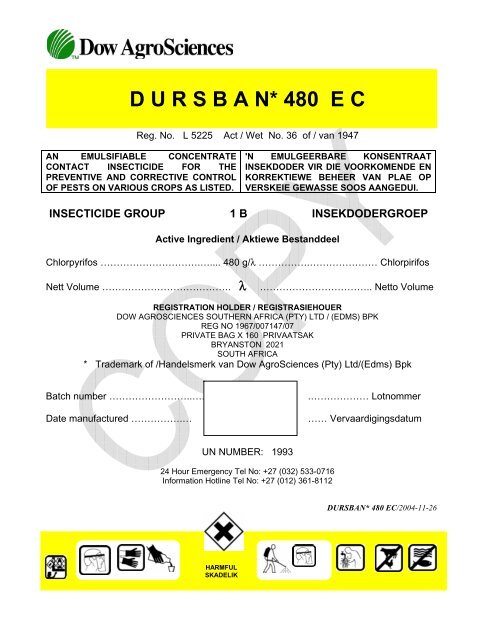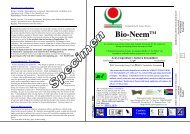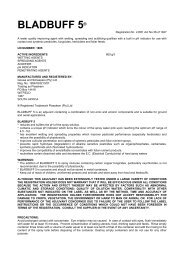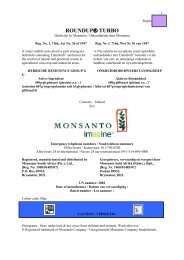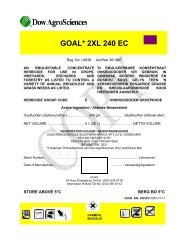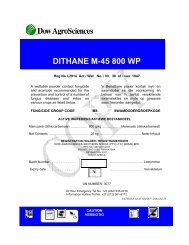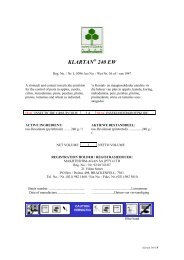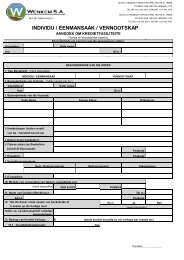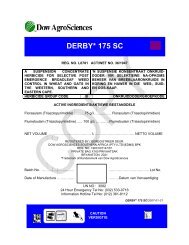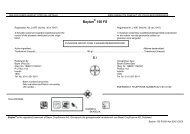D U R S B A N* 480 E C - Wenkem
D U R S B A N* 480 E C - Wenkem
D U R S B A N* 480 E C - Wenkem
You also want an ePaper? Increase the reach of your titles
YUMPU automatically turns print PDFs into web optimized ePapers that Google loves.
D U R S B A <strong>N*</strong> <strong>480</strong> E C<br />
Reg. No. L 5225 Act / Wet No. 36 of / van 1947<br />
AN EMULSIFIABLE CONCENTRATE<br />
CONTACT INSECTICIDE FOR THE<br />
PREVENTIVE AND CORRECTIVE CONTROL<br />
OF PESTS ON VARIOUS CROPS AS LISTED.<br />
INSECTICIDE GROUP<br />
1 B<br />
'N EMULGEERBARE KONSENTRAAT<br />
INSEKDODER VIR DIE VOORKOMENDE EN<br />
KORREKTIEWE BEHEER VAN PLAE OP<br />
VERSKEIE GEWASSE SOOS AANGEDUI.<br />
Active Ingredient / Aktiewe Bestanddeel<br />
INSEKDODERGROEP<br />
Chlorpyrifos ………………………….….... <strong>480</strong> g/λ …………….………………… Chlorpirifos<br />
Nett Volume …………………………………. λ …………………………….. Netto Volume<br />
REGISTRATION HOLDER / REGISTRASIEHOUER<br />
DOW AGROSCIENCES SOUTHERN AFRICA (PTY) LTD / (EDMS) BPK<br />
REG NO 1967/007147/07<br />
PRIVATE BAG X 160 PRIVAATSAK<br />
BRYANSTON 2021<br />
SOUTH AFRICA<br />
* Trademark of /Handelsmerk van Dow AgroSciences (Pty) Ltd/(Edms) Bpk<br />
Batch number ……………………..…. .……………… Lotnommer<br />
Date manufactured …………….… …… Vervaardigingsdatum<br />
UN NUMBER: 1993<br />
24 Hour Emergency Tel No: +27 (032) 533-0716<br />
Information Hotline Tel No: +27 (012) 361-8112<br />
HARMFUL<br />
SKADELIK<br />
DURSBA<strong>N*</strong> <strong>480</strong> EC/2004-11-26
WARNINGS<br />
Withholding periods - Minimum time between last application and harvest or feeding :-<br />
Apples (summer spray) 40 days<br />
Bananas 28 days<br />
Brocolli, brussel sprouts, cabbage, cauliflower 7 days<br />
Carrots 21 days<br />
Dry beans 32 days<br />
Lettuce 21 days<br />
Maize, grain sorghum 32 days<br />
Pastures 14 days<br />
Potatoes 7 days<br />
Tobacco 50 days<br />
Tomatoes 4 days<br />
Wheat 32 days<br />
Wine grapes 28 days<br />
Handle with care.<br />
Poisonous when absorbed through the skin, swallowed or inhaled. Toxic to fish, bees and<br />
wildlife.<br />
FLAMMABLE : Do not store near open flames.<br />
Store in a cool place.<br />
Store away from food and feedstuffs.<br />
Keep out of reach of children, uninformed persons and animals.<br />
Re-entry period. Do not enter treated fields/orchards within 1 day after application unless<br />
wearing protective clothing.<br />
In case of poisoning, call a doctor immediately and make this label available to<br />
him/her.<br />
AERIAL APPLICATION: Notify all inhabitants of the immediate area to be sprayed and issue<br />
the necessary warnings. Do not spray over or allow drift to contaminate water or adjacent<br />
areas.<br />
Although this remedy has been extensively tested under a large variety of conditions<br />
the registration holder does not warrant that it will be efficacious under all conditions<br />
because the action and effect thereof may be affected by factors such as abnormal<br />
soil, climatic and storage conditions; quality of dilution water, compatibility with other<br />
substances not indicated on the label and the occurrence of resistance of the pest<br />
against the remedy concerned as well as by the method, time and accuracy of<br />
application. The registration holder furthermore does not accept responsibility for<br />
damage to crops, vegetation, the environment or harm to man or animal or for lack of<br />
performance of the remedy concerned due to failure of the user to follow the label<br />
instructions or to the occurrence of conditions which could not have been foreseen in<br />
terms of the registration. Consult the supplier in the event of any uncertainty.<br />
1<br />
DURSBA<strong>N*</strong> <strong>480</strong> EC/2004-11-26
PRECAUTIONS<br />
Avoid inhalation of spray mist. Wear protective clothing whilst mixing and applying –<br />
protective gloves and face shield. Wash with soap and water after use or accidental skin<br />
contact. Do not eat, drink or smoke while mixing and applying or before washing hands and<br />
face. Avoid spray drift onto other crops, grazing, rivers and dams. Clean applicators before<br />
using for other remedies and dispose of wash water where it will not contaminate crops,<br />
grazing, rivers and dams. Invert the empty container for at least 30 seconds after the flow<br />
has slowed down to a drip. Thereafter rinse the container three times with a volume of water<br />
equal to a minimum of 10 % of that of the container. Add the rinsings to the contents of the<br />
spray tank before destroying the container by perforation, flattening and burying and do not<br />
use for any other purpose. Avoid contamination of food, feedstuffs, drinking water and eating<br />
utensils.<br />
SYMPTOMS OF HUMAN POISONING<br />
Headaches, fatigue, faintness, giddiness, excessive sweating, nausea, abdominal pains,<br />
vomiting, diarrhoea, tightness of chest, anxiety, blurred vision, muscle twitching beginning in<br />
eyelids and tongue, usually small pupils, respiratory distress, convulsions, coma.<br />
FIRST AID TREATMENT<br />
Ingestion<br />
Do not induce vomiting. Call a physician and/or transport to emergency facility immediately.<br />
The decision of whether to induce vomiting or not should be made by an attending physician.<br />
Never give fluids or induce vomiting if patient is unconscious or is having convulsions.<br />
Eye contact<br />
Irrigate immediately with water for at least 5 minutes. Consult medical personnel.<br />
Skin contact<br />
Immediately wash skin with soap and plenty of water. Remove contaminated clothing. Wash<br />
contaminated clothing before re-use.<br />
Inhalation<br />
Remove to fresh air. Consult a physician.<br />
2<br />
DURSBA<strong>N*</strong> <strong>480</strong> EC/2004-11-26
NOTE TO PHYSICIAN<br />
This material contains both a cholinesterase inhibitor and a solvent. Atropine, only by<br />
injection, is the preferable antidote. Oximes, such as 2-PAM/protopam, may be therapeutic if<br />
used early; however, use only in conjunction with atropine. If lavage is performed, suggest<br />
endotracheal and/or oesophageal control. Danger from lung aspiration must be weighed<br />
against toxicity when considering emptying the stomach. Supportive care. Treatment based<br />
on judgement of physician in response to symptoms of patient.<br />
RESISTANCE WARNING:<br />
For resistance management, DURSBAN <strong>480</strong> EC is a group 1B insecticide. Any insect<br />
population may contain individuals naturally resistant to DURSBAN <strong>480</strong> EC and other group<br />
1B insecticides. The resistant individuals can eventually dominate the insect population if<br />
these insecticides are used repeatedly. These resistant insects may not be controlled by<br />
DURSBAN <strong>480</strong> EC or any other group 1B insecticide.<br />
To delay insecticide resistance:<br />
• Avoid exclusive repeated use of insecticides from the same insecticide group codes.<br />
• Do not use insecticides at lower rates than prescribed on label.<br />
• Where possible target applications against early larval or egg stages of applicable pest.<br />
• Integrate other control methods (chemical, cultural, biological) into insect control<br />
programmes.<br />
For specific information on resistance management contact the registration holder of this<br />
product.<br />
DIRECTIONS FOR USE: Use only as directed.<br />
AERIAL APPLICATION<br />
Aerial application of DURSBAN <strong>480</strong> EC may only be done by a registered aerial application<br />
operator using a registered and correctly calibrated aircraft according to the instructions of<br />
SANS 10118 (Aerial Application of Agricultural Pesticides). Ensure that the spray mixture is<br />
distributed evenly over the target area and that the loss of spray material during application is<br />
restricted to a minimum. It is therefore essential that the following criteria be met;<br />
3<br />
DURSBA<strong>N*</strong> <strong>480</strong> EC/2004-11-26
• Volume: A spray mixture volume of 30 λ per hectare is recommended. As this product<br />
has not been evaluated at a reduced volume rate, the registration holder cannot guarantee<br />
efficacy, or be held responsible for any adverse effects if this product is applied aerially at<br />
a lower volume rate than recommended above.<br />
• Droplet coverage: 30 to 40 droplets per cm² must be recovered at the target area.<br />
• Droplet size: A droplet spectrum with a VMD of 250 to 280 microns is recommended.<br />
Limit the production of fine droplets less than 150 microns (high drift and evaporation<br />
potential) to a minimum.<br />
• Flying height: Maintain the height of the spray boom at 3 to 4 metres above the target.<br />
Do not spray when aircraft dives, is in a climb or when banking.<br />
• Use suitable atomizing equipment that will produce the desired droplet size and coverage,<br />
but which will ensure the minimum loss of product. The spraying system must produce a<br />
droplet spectrum with the lowest possible Relative Span.<br />
• Position all the atomizers within the inner 60 to 75 % of the wingspan to prevent droplets<br />
from entering the wingtip vortices.<br />
• The difference in temperature between the wet and dry bulb thermometers, of a whirling<br />
hygrometer, should not exceed 8°C.<br />
• Stop spraying if the wind speed exceeds 15 km/h.<br />
• Stop spraying under turbulent, unstable and dry conditions during the heat of the day.<br />
• Spraying under temperature inversion conditions (spraying in or above the inversion layer)<br />
and/or high humidity conditions (relative humidity 80 % and above) may lead to the<br />
following:<br />
- reduced efficacy due to suspension and evaporation of small droplets in the<br />
air (inadequate coverage),<br />
- damage to other sensitive crops and/or non-target areas through drifting of<br />
the suspended spray cloud away from the target field.<br />
• Ensure that the Aerial Spray Operator knows exactly which fields to spray.<br />
Obtain an assurance from the Aerial Spray Operator that the above requirements will be met<br />
and that relevant data will be compiled in a logbook and kept for future reference.<br />
COMPATIBILITY<br />
DURSBA<strong>N*</strong> <strong>480</strong> EC is compatible with light-narrow range mineral oil, dimethoate (400 g/l) EC<br />
lapsed.<br />
4<br />
DURSBA<strong>N*</strong> <strong>480</strong> EC/2004-11-26
APPLICATION<br />
Dosage rates indicated per 100 litres water are for high volume spraying.<br />
CROP/PEST<br />
APPLES<br />
Woolly aphid<br />
DOSAGE /<br />
100 λ WATER<br />
OR AS<br />
INDICATED<br />
75 mλ<br />
5<br />
REMARKS<br />
Summer spray only<br />
PRE-HARVEST WOOLLY APHID CONTROL:<br />
Apply as a full cover spray when the pest starts<br />
moving upwards into the trees or when first<br />
noticed. If colonization is observed after the<br />
initial application, apply a second spray not later<br />
than 40 days before harvest.<br />
The required spray volume per hectare for a<br />
specific growth stage should be accurately<br />
calculated according to the Unrath tree row<br />
volume method (Deciduous Fruit Grower,<br />
November, 1986). The sprays applied to control<br />
woolly aphid will also control codling moth for a<br />
period of 14 days. Spray Golden Delicious<br />
apples only if absolutely necessary as<br />
ringmarking of fruit may occur under certain<br />
growing conditions.<br />
The DURSBA<strong>N*</strong> <strong>480</strong> EC spray will suppress<br />
pernicious scale and mealybug.<br />
POST-HARVEST WOOLLY APHID CONTROL:<br />
If necessary, apply a DURSBAN spray as soon<br />
as possible after harvest.<br />
DURSBA<strong>N*</strong> <strong>480</strong> EC/2004-11-26
CROP/PEST<br />
APPLES, PEARS,<br />
PEACHES, PLUMS<br />
AND APRICOTS<br />
Pernicious scale<br />
APPLES AND PEARS<br />
Mealy bug<br />
BANANAS<br />
Banana silvering thrips<br />
and mites<br />
DOSAGE /<br />
100 λ WATER<br />
OR AS<br />
INDICATED<br />
75 mλ + 500 mλ<br />
Cipron* or BP<br />
Medium Spray<br />
Oil*<br />
100 - 200 mλ<br />
75 mλ<br />
6<br />
REMARKS<br />
Dormant application only.<br />
Apply at least two high volume sprays at 4-week<br />
intervals during the dormant stage of trees.<br />
(One before and one after pruning.)<br />
Note: When DURSBAN <strong>480</strong> EC is applied in<br />
combination with restbreak oil, the addition<br />
of Cipron or Medium Spray is not necessary.<br />
Dormant application only<br />
Apply two high volume sprays.<br />
First spray approximately 3 – 4 weeks before<br />
bud swell / green tip.<br />
Second spray at bud swell / green tip. Use<br />
higher dose rate where more than 1 % fruit<br />
infestation was experienced the previous<br />
season.<br />
DURSBAN <strong>480</strong> EC is compatible with mineral oil<br />
or mineral oil + cyanamide used against delayed<br />
foliation.<br />
Ground application only<br />
Apply as a high volume spray and assure good<br />
coverage of each bunch. Commence spraying<br />
at the end of July and repeat every 4 weeks until<br />
February.<br />
DURSBA<strong>N*</strong> <strong>480</strong> EC/2004-11-26
CROP/PEST<br />
CABBAGE,<br />
CAULIFLOWER,<br />
BROCOLLI AND<br />
BRUSSEL SPROUTS<br />
Aphids (Brevicoryne<br />
brassicae) and<br />
Diamond black moth<br />
(Plutella maculipennis)<br />
HOPS<br />
Cutworm<br />
LAWNS<br />
Lawn Caterpillars<br />
Crickets<br />
MAIZE, GRAIN<br />
SORGHUM AND DRY<br />
BEANS<br />
Black Maize Beetle<br />
DOSAGE / 100 λ<br />
WATER OR AS<br />
INDICATED<br />
50 mλ<br />
50 - 75 mλ<br />
5 mλ/10 λ water<br />
Row application<br />
10 mλ/100 m row<br />
length in 3 λ<br />
water.<br />
Overall<br />
application 1 λ/ha<br />
7<br />
REMARKS<br />
Apply when pest is first noticed. Do not apply<br />
less than 500 λ spray mixture/ha. Ensure<br />
thorough coverage of the whole plant. When<br />
aphids or the Plutella larvae are already in the<br />
cabbage head, or in the clusters of leaves of<br />
the brussel sprouts, variable control can be<br />
expected. The adding of a wetting agent is<br />
recommended. Re-apply when necessary.<br />
Apply as an overall application only on the<br />
plant rows during or shortly after plant<br />
emergence. Apply at least 500 litres spray<br />
mixture/ha. Use the lower rate for low<br />
infestations and/or early instar larvae.<br />
Apply 500 mλ of the mixture per square metre<br />
as a drench when pest is noticed. Repeat<br />
application weekly until the population is under<br />
control and thereafter as necessary.<br />
Spray into the planting furrow, just behind<br />
planter shoe before closing furrow.<br />
Apply in 200 λ water as an overall spray at<br />
planting and mix with the soil to a depth of<br />
100 mm by using a suitable implement, eg. a<br />
disc or Fieldspan.<br />
NOTE: Less effective control can be expected<br />
under dry soil conditions.<br />
DURSBA<strong>N*</strong> <strong>480</strong> EC/2004-11-26
MAIZE<br />
Stalkborer<br />
CROP/PEST<br />
ORNAMENTALS<br />
Red spider mite<br />
PASTURES<br />
Army worm<br />
PINEAPPLES<br />
White grubs<br />
Black maize beetle<br />
DOSAGE / 100 λ<br />
WATER OR AS<br />
INDICATED<br />
3,5 mλ/100 m<br />
row length in 3 λ<br />
water<br />
10 mλ/10 λ water<br />
250 mλ/ha<br />
10 λ/ha<br />
8<br />
REMARKS<br />
Ground application: Early planting - Apply<br />
when 5 % of the plants are infested with eggs<br />
or when 10 % plants show "shot hole" damage.<br />
If control of this infestation is delayed too long,<br />
the larvae may be protected inside the stalk<br />
and poor results can be expected.<br />
Late planting: Apply the first spray 30 - 35<br />
days after planting and repeat 14 days later.<br />
Only apply up to the stage before the tassels<br />
are enclosed by the flag leaf.<br />
Apply as a full cover spray ensuring under leaf<br />
coverage. Repeat as necessary every 14<br />
days.<br />
Apply in 200 - 500 litres water per hectare.<br />
Apply in 2200 λ water by sprayboom to soil<br />
which has been prepared to a fine tilth for<br />
ridging; incorporate 100 mm - 200 mm deep<br />
by disc ploughing or rotary hoeing with<br />
minimal delay i.e. within an hour or two, as the<br />
active ingredient is rapidly broken down by<br />
sunlight. Complete the operation by ridging<br />
and planting.<br />
DURSBA<strong>N*</strong> <strong>480</strong> EC/2004-11-26
CROP/PEST<br />
POTATOES<br />
Black Maize beetle and<br />
cutworm<br />
DOSAGE / 100 λ<br />
WATER OR AS<br />
INDICATED<br />
Programme<br />
application:<br />
Pre-plant<br />
15 mλ/100 m row<br />
length in 3 λ<br />
water<br />
Post-plant<br />
500 mλ/ha<br />
9<br />
REMARKS<br />
Apply as a pre-plant treatment in a 100 mm<br />
band just before closing the furrows.<br />
Apply 6 weeks later in not less than 500 λ<br />
water/ha and increase the volume of water with<br />
the increase in crop density. Repeat at<br />
intervals of 2 - 3 weeks. Use drop arms and<br />
ensure a good ground coverage. Rain or<br />
ridging is essential for good control.<br />
Cutworm 1 λ/ha Apply just prior to tuber initiation in not less<br />
than 500 λ water/ha and increase the volume<br />
of water with the increase of crop density.<br />
Repeat at 2- 3 week intervals. Use drop arms<br />
and ensure a good ground coverage. Rain or<br />
ridging is essential for good control.<br />
RASPBERRIES IN<br />
POTS (Eurafruit<br />
producers ONLY)<br />
Banded Fruit Weevil<br />
(Phlyctinus callosus)<br />
200 mλ<br />
Post harvest application: Apply 1 λ of spray<br />
mixture per pot as a drench 1 - 2 times from<br />
February to May.<br />
Dormant stage application: Apply 1 λ of<br />
spray mixture per pot as a drench 1 - 2 times<br />
depending on infestation. Final application to<br />
be made not later than 3 weeks after bud<br />
break.<br />
DURSBA<strong>N*</strong> <strong>480</strong> EC/2004-11-26
CROP/PEST<br />
TABLE GRAPES<br />
Mealy bug<br />
DOSAGE / 100 λ<br />
WATER OR AS<br />
INDICATED<br />
200 mλ<br />
(Two<br />
applications)<br />
10<br />
REMARKS<br />
Dormant spray only: Apply two sprays in the<br />
late winter dormant period. The first spray<br />
should commence approximately 6 weeks<br />
before bud burst. The second spray should be<br />
applied a minimum of 7 days after the first<br />
spray but before any signs of green material<br />
are evident. (DURSBA<strong>N*</strong> <strong>480</strong> EC is phytotoxic<br />
to young vineleaves).<br />
Method of application: Use only hand gun type<br />
high volume sprays. Vines should be<br />
individually drenched down to ground level with<br />
a minimum of 4 λ of spray mixture per vine.<br />
Follow up sprays: In certain vineyards high<br />
mealy bug pressure and poor application might<br />
necessitate follow up sprays in the summer.<br />
As soon as mealy bug is observed apply a<br />
suitable registered chemical. Where possible<br />
apply spot treatment only.<br />
Cocktail ants 400 mλ Dormant spray only: Apply as a single spray<br />
where cocktail ants are present. Apply as a<br />
high volume application to ensure optimal<br />
coverage. NOTE: This application will also<br />
suppress Argentine ants if present at<br />
application.<br />
TOBACCO<br />
Cutworm and lesser<br />
wireworm<br />
200 mλ<br />
Apply 30 mλ per plant as a stem treatment and<br />
ensure thorough wetting of the stem and soil<br />
surrounding the base of the plant. Do not<br />
apply over the heart of the plant as this can<br />
cause leaf damage. Repeat if necessary.<br />
DURSBA<strong>N*</strong> <strong>480</strong> EC/2004-11-26
CROP/PEST<br />
TOMATOES<br />
American bollworm<br />
(Heliothis armigera) and<br />
Semi- (Plusia) looper<br />
(Plusia acuta)<br />
DOSAGE / 100 λ<br />
WATER OR AS<br />
INDICATED<br />
150 - 200 mλ<br />
11<br />
REMARKS<br />
Apply as a full cover spray and repeat every 7<br />
days. When a heavy infestation occurs, 200<br />
mλ/100 λ water is recommended. Repeat this<br />
application every 7 days until population is<br />
under control. After pests have been brought<br />
under control continue spraying the lower<br />
dosage rate (150 mλ) every 7 days.<br />
Thrips 150 - 200 mλ Apply as a full cover spray and repeat every 7<br />
days. The above spray programme for<br />
American bollworm and Semi- (Plusia) looper<br />
will also control Thrips.<br />
WESTERN CAPE<br />
ONLY<br />
CARROTS AND<br />
POTATOES<br />
Cutworm<br />
LETTUCE<br />
Cutworm<br />
1 λ/ha<br />
1 λ/ha<br />
Apply as an overall application when plants<br />
emerge. Repeat application at intervals of 2<br />
- 3 weeks. Apply in at least 500 λ water.<br />
Apply as an overall application when plants<br />
emerge. Repeat application every 7 - 14 days<br />
when necessary. Apply in at least 500 λ water.<br />
DURSBA<strong>N*</strong> <strong>480</strong> EC/2004-11-26
CROP/PEST<br />
WHEAT<br />
Russian Wheat aphid<br />
(Diuraphis noxia)<br />
Schizaphis graminum<br />
(common green wheat<br />
aphid)<br />
Rhopalosiphum padi<br />
(rose aphid)<br />
DOSAGE / 100 λ<br />
WATER OR AS<br />
INDICATED<br />
750 mλ/ha<br />
12<br />
REMARKS<br />
Ground application: Apply as an overall spray<br />
when first signs of infestation are observed.<br />
Repeat spray 8 - 10 days later, if necessary.<br />
Apply in 200 - 300 λ water/ha depending on<br />
size of plants.<br />
1 λ In the event of high aphid populations, apply<br />
1, 0 λ/ha when first signs of infestation are<br />
observed. Repeat spray 8 - 10 days later, if<br />
necessary, using a lower dosage rate of<br />
750 mλ/ha.<br />
0,75 - 1 λ/ha Aerial application: Using 1 λ/ha start spraying<br />
when first signs of infestation are observed.<br />
Repeat spray 8 - 10 days later, if necessary,<br />
using a lower dosage rate of 750 mλ/ha. Apply<br />
in not less than 30 λ water/ha.<br />
Note: These applications will also control other<br />
aphid species if present and suppress black<br />
maize beetle.<br />
750 mλ/ha Ground application: Apply in minimum of 300 λ<br />
water/ha. Repeat after 10 - 14 days if<br />
necessary.<br />
DURSBA<strong>N*</strong> <strong>480</strong> EC/2004-11-26
CROP/PEST<br />
WINE GRAPES<br />
Mealy bug<br />
(low infestation<br />
pressure)<br />
Mealy bug<br />
(high infestation<br />
pressure)<br />
Mealy bug and<br />
suppression of<br />
Argentine ants<br />
DOSAGE / 100 λ<br />
WATER OR AS<br />
INDICATED<br />
100 mλ<br />
(two applications)<br />
200 mλ<br />
(two applications)<br />
13<br />
REMARKS<br />
Dormant Spray only: Apply two applications<br />
at two week intervals before bud burst. Apply<br />
as a high volume application to ensure<br />
optimum coverage of the vines.<br />
Note: This application will also control<br />
cocktail ants and suppress Argentine ants if<br />
present at application (at lower dosage<br />
suppression only).<br />
75 mλ Summer spray only: Apply when the first<br />
movement of mealy bug is noticed. Apply as<br />
a high volume application ensuring thorough<br />
coverage of the vines. Repeat after 21 days<br />
if necessary. Do not apply during bud swell<br />
or within 4 weeks after budding as DURSBAN<br />
can be phytotoxic to young vine leaves.<br />
* Cipron (Reg. No. L6133) and Medium Spray Oil (Reg. No. L6491) is trade names of BP<br />
South Africa (Pty) Ltd<br />
24 HOUR EMERGENCY TEL. NO. (032) 533-0716<br />
INFORMATION HOTLINE : TEL. NO.: (012) 361-8112<br />
DURSBA<strong>N*</strong> <strong>480</strong> EC/2004-11-26
WAARSKUWINGS<br />
Onthoudingsperiodes - Minimum tyd wat moet verstryk tussen die laaste toediening en oes<br />
of voer/beweiding :-<br />
Aartappels 7 dae<br />
Appels (somer bespuiting) 40 dae<br />
Blaarslaai 21 dae<br />
Blomkool, brokkoli, brusselse spruite, kopkool 7 dae<br />
Droëbone 32 dae<br />
Geelwortels 21 dae<br />
Koring 32 dae<br />
Mielies, graansorghum 32 dae<br />
Piesangs 28 dae<br />
Tamaties 4 dae<br />
Tabak 50 dae<br />
Weiding 14 dae<br />
Wyndruiwe 28 dae<br />
Hanteer versigtig.<br />
Giftig indien deur die vel geabsorbeer, ingesluk of ingeasem word.<br />
Giftig vir visse, heuningbye en wild.<br />
VLAMBAAR: Moenie naby oop vlamme berg nie.<br />
Berg in ‘n koel plek.<br />
Berg weg van kos en voer.<br />
Hou buite bereik van kinders, oningeligte persone en diere.<br />
Herbetredingsperiode: Moet nie behandelde lande/boorde binne 1 dag na bespuiting betree<br />
sonder beskermende klere nie.<br />
In die geval van vergiftiging ontbied onmiddellik 'n geneesheer en stel hierdie etiket<br />
aan hom/haar beskikbaar.<br />
LUGTOEDIENING: Stel alle inwoners in die nabye omgewing van die lugbespuitingsarea in<br />
kennis en reik die nodige waarskuwings uit. Voorkom besoedeling en wegdrywe van<br />
spuitnewel na water of aangrensende gewasse en gebiede.<br />
Alhoewel hierdie middel omvattend onder ‘n groot verskeidenheid toestande getoets is<br />
waarborg die registrasiehouer nie dat dit onder alle toestande doeltreffend sal wees<br />
nie aangesien die werking en effek daarvan beïnvloed kan word deur faktore soos<br />
abnormale grond-, klimaats- en bergingstoestande; kwaliteit van verdunningswater,<br />
verenigbaarheid met ander stowwe wat nie op die etiket is nie en die voorkoms van<br />
weerstand van die plaag teen die betrokke middel sowel as die metode, tyd en<br />
akkuraatheid van toediening. Verder aanvaar die registrasiehouer nie<br />
verantwoordelikheid vir skade aan gewasse plantegroei, die omgewing of vir nadelige<br />
effek op mens of dier of vir ‘n gebrek aan prestasie van die betrokke middel as gevolg<br />
van die versuim van die gebruiker om etiketaanwysings na te kom of as gevolg van die<br />
14<br />
DURSBA<strong>N*</strong> <strong>480</strong> EC/2004-11-26
ontstaan van toestande wat nie kragtens die registrasie voorsien kon word nie.<br />
Raadpleeg die verskaffer in die geval van enige onsekerheid.<br />
VOORSORGMAATREëLS<br />
Vermy inaseming van sproeinewel.<br />
Dra beskermende klere tydens menging en toediening – beskermende handskoene en<br />
gesigskerm.<br />
Was met seep en water na gebruik of toevallige velkontak.<br />
Moet nie eet, drink of rook terwyl gemeng of toegedien word of voordat hande en gesig<br />
gewas word nie.<br />
Vermy wegdrywing van sproeinewel na ander gewasse, weidings, riviere en damme.<br />
Maak toerusting skoon voordat vir ander middels gebruik word en gooi spoelwater weg waar<br />
die nie gewasse, weidings, riviere en damme sal besoedel nie.<br />
Keer die leë houer om oor die spuittenk of mengbak en dreineer vir minstens 30 sekondes<br />
nadat die vloei tot ‘n gedrup verminder het. Spoel die houer daarna driekeer uit met ‘n<br />
volume water gelykstaande aan ‘n minimum van 10 % van die houer. Gooi die spoelwater by<br />
die inhoud van die spuittenk voordat die houer vernietig word deur gate in te kap, plat te slaan<br />
en begrawe word en moet nie vir enige ander doel gebruik nie.<br />
Vermy besoedeling van voedsel, voer, drinkwater en eetgerei.<br />
SIMPTOME VAN MENSLIKE VERGIFTIGING<br />
Hoofpyn, vermoeidheid, swakte, duiselikheid, oormatige sweet, mislikheid, buikpyn, braking,<br />
buikloop, beklemde bors, benoudheid, versteurde gesigsvermoë, spiertrekkings beginnende<br />
by die ooglede en tong, gewoonlik verkleinde pupille, stuiptrekkings, asemnood,<br />
bewusteloosheid.<br />
15<br />
DURSBA<strong>N*</strong> <strong>480</strong> EC/2004-11-26
NOODHULPBEHANDELING<br />
Inname: Moet nie braking induseer nie. Raadpleeg dadelik 'n mediese praktisyn en/of neem<br />
pasiënt na 'n mediese fasiliteit. Die besluit om braking aan te help moet deur 'n mediese<br />
praktisyn gemaak word. Moet nooit vloeistowwe gee aan of braking induseer by 'n persoon<br />
wat bewusteloos is of stuiptrekkings het nie.<br />
Oogkontak: Spoel oë dadelik uit met water vir ten minste 5 minute. Raadpleeg mediese<br />
personeel.<br />
Velkontak: Was vel dadelik met seep en baie water. Trek besoedelde klere uit. Was<br />
besoedelde klere voor hergebruik.<br />
Inaseming: Verwyder persoon na vars lug. Raadpleeg 'n mediese praktisyn.<br />
NOTA AAN GENEESHEER:<br />
Die produk (Dursban EC), bevat beide 'n chlolinesterase onderdrukker en 'n oplosmiddel.<br />
Atropien inspuiting is die aanbevole teenmiddel. Alhoewel Oksieme soos 2-PAM/protopam,<br />
terapeuties mag wees indien vroegtydig toegedien; word dit egter altyd saam met Atropien<br />
aanbeveel. Indien maagspoeling oorweeg word, word endotrageale en/of oesophageale<br />
beheer aanbeveel. Gevaar van long aspirasie (verwydering van vog), moet opgeweeg word<br />
teenoor toksisiteit, indien oorweeg word om die maag leeg te maak. Ondersteunende<br />
versorging word aanbeveel. Behandeling moet gebaseer word op die dokter se interpretasie<br />
van die simptome.<br />
WEERSTANDSWAARSKUWING:<br />
DURSBAN <strong>480</strong> EC is ‘n groepkode 1B insekdoder. Enige populasie van ‘n spesifieke insek<br />
mag individue insluit wat ‘n natuurlike weerstand teen DURSBAN <strong>480</strong> EC, of enige ander<br />
groepkode 1B insekdoder het. Indien hierdie insekdoders herhaaldelik aangewend word, kan<br />
die weerstandbiedende individue uiteindelik die insekpopulasie oorheers. Hierdie<br />
weerstandbiedende insekte sal waarskynlik nie deur DURSBAN <strong>480</strong> EC of enige ander<br />
groepkode 1B insekdoder beheer word nie.<br />
16<br />
DURSBA<strong>N*</strong> <strong>480</strong> EC/2004-11-26
Om insekweerstand te vertraag:<br />
• Vermy die eksklusiewe gebruik van insekdoders van dieselfde subgroep.<br />
• Moenie insekdoders teen laer dosisse, as wat op die etiket voorgeskryf word, aanwend<br />
nie.<br />
• Rig toedienings verkieslik en waar enigsins moontlik, teen die jonger larwale- of die<br />
eierstadium van 'n betrokke plaag.<br />
• Integreer ander beheermaatreëls (chemies, bewerking, biologies) in insekbeheer<br />
programme.<br />
GEBRUIKSAANWYSINGS<br />
Gebruik alleenlik soos aangedui.<br />
LUGTOEDIENING<br />
DURSBAN <strong>480</strong> EC kan slegs deur ‘n geregistreerde Lugbespuitingsoperateur met ‘n korrek<br />
gekalibreerde, geregistreerde vliegtuig volgens die instruksies van SANS 10118 (Aerial<br />
Application of Agricultural Pesticides) uit die lug bespuit word. Verseker dat die spuitmengsel<br />
eweredig oor die teikenarea versprei word, en die verlies aan spuitmengsel tydens toediening<br />
tot ’n minimum beperk word. Dit is daarom belangrik om aan die volgende vereistes te<br />
voldoen:<br />
• Volume: 'n Spuitmengsel volume van 30 liter per hektaar word aanbeveel. Hierdie produk<br />
is nie teen 'n verlaagde volume getoets nie. Die registrasiehouer kan nie effektiwiteit<br />
waarborg, of verantwoordelik gehou word vir enige nadelige effekte indien hierdie produk<br />
teen 'n laer volume, as hierbo aanbeveel, toegedien word nie.<br />
• Druppelbedekking: 30 tot 40 druppels per cm² moet op die teikenarea herwin word.<br />
• Druppelgrootte: 'n Druppelspektrum met 'n VMD van 250 tot 280 mikrons word<br />
aanbeveel. Beperk die produksie van druppels kleiner as 150 mikrons (hoë drywing en<br />
verdampingspotensiaal) tot 'n minimum.<br />
• Vlieghoogte: Handhaaf die hoogte van die spuitbalk bo die teiken op 3 tot 4 meter. Moet<br />
nie spuit wanneer die vliegtuig duik, uitklim of draai nie.<br />
• Gebruik geskikte atomiseringsapparaat wat die vereiste druppelgrootte en bedekking sal<br />
produseer, maar die minste verlies van produk verseker. Die spuitstelsel moet ’n<br />
druppelspektrum met die kleinste moontlike Relatiewe Span produseer.<br />
• Plaas al die atomiseerders in die binneste 60 tot 75 % van die vlerkspan om te verhoed<br />
dat druppels binne-in die vlerkpuntvorteks beweeg.<br />
• Die verskil in temperatuur tussen die nat- en droëboltermometer van 'n swaaihigrometer,<br />
moet nie 8°C oorskry nie.<br />
• Stop bespuiting indien die windspoed 15 km/h oorskry.<br />
17<br />
DURSBA<strong>N*</strong> <strong>480</strong> EC/2004-11-26
• Stop bespuiting tydens turbulente, onstabiele en droë toestande gedurende die hitte van<br />
die dag.<br />
• Bespuiting onder temperatuur inversie toestande (deur bo of binne die inversie laag te<br />
spuit) en/of hoë lugvog toestande (relatiewe humiditeit 80 % en meer) mag tot volgende<br />
probleme aanleiding gee:<br />
- verlaagde effektiwiteit aangesien die druppels as 'n wolk in die lug bly hang<br />
en moontlik verdamp (onvoldoende bedekking op teiken),<br />
- skade aan nie-teiken gewasse of sensitiewe areas as gevolg van<br />
wegdrywing van die spuitwolk na nie-teiken area.<br />
• Verseker dat die Lugbespuitingsoperateur presies weet watter lande bespuit moet word.<br />
Dit is noodsaaklik om 'n versekering van die Lugbespuitingsoperateur te verkry dat aan al die<br />
bogenoemde vereistes voldoen sal word en dat data van belang in ’n logboek saamgevat is<br />
vir toekomstige verwysing.<br />
VERENIGBAARHEID<br />
DURSBA<strong>N*</strong> <strong>480</strong> EC is verenigbaar met ligte-smalfraksie minerale olie, dimethoat (400 g/λ)<br />
EC.<br />
TOEDIENING<br />
Hoeveelheid aangedui per 100 liter water is bedoel vir hoë volume bespuitings.<br />
GEWAS/PLAAG<br />
AARTAPPELS<br />
Swartmieliekewer en<br />
Snywurm<br />
HOEVEELHEID /<br />
100 λ WATER OF<br />
SOOS AANGEDUI<br />
Program toediening<br />
Voorplant<br />
15 mλ/100 m rylengte<br />
in 3 λ water<br />
Na-plant<br />
500 mλ/ha<br />
18<br />
OPMERKINGS<br />
Dien toe as 'n voorplant toediening in 'n<br />
100 mm strook net voordat plantvoor<br />
toegemaak word.<br />
Dien toe 6 weke later in nie minder as<br />
500 λ water/ha en vermeerder die volume<br />
water met die toename in gewasdigtheid.<br />
Herhaal met 2 - 3 weke tussenposes.<br />
Gebruik valarms en verseker sodoende 'n<br />
goeie grondbedekking. Reën of operd na<br />
toediening is noodsaaklik vir goeie<br />
beheer.<br />
DURSBA<strong>N*</strong> <strong>480</strong> EC/2004-11-26
GEWAS/PLAAG<br />
AARTAPPELS (verv.)<br />
Snywurm<br />
APPELS<br />
Bloedluis<br />
HOEVEELHEID /<br />
100 λ WATER OF<br />
SOOS AANGEDUI<br />
1 λ/ha<br />
75 mλ<br />
19<br />
OPMERKINGS<br />
Dien toe net voor knolvorming begin in nie<br />
minder as 500 λ water/ha en vermeerder die<br />
volume water met die toename van<br />
gewasdigtheid. Herhaal met 2 - 3 weke<br />
tussenposes. Gebruik valarms en verseker<br />
sodoende 'n goeie grondbedekking. Reën of<br />
operd na toediening is noodsaaklik vir goeie<br />
beheer.<br />
Slegs somerbespuiting:<br />
VOOROES BEHEER VAN BLOEDLUIS:<br />
Dien as 'n volle dekbespuiting toe wanneer<br />
plaag opwaarts in die bome begin in-beweeg<br />
of sodra dit waargeneem word. Indien<br />
kolonisering na die aanvanklike bespuiting<br />
waargeneem word, dien 'n opvolgbespuiting<br />
toe nie later as 40 dae voor oes nie.<br />
Spuitvolumes benodig per hektaar vir 'n<br />
spesifieke groeistadium moet akkuraat<br />
volgens die boomryvolume metode van<br />
Unrath (Sagtevrugboer, November, 1986)<br />
bepaal word. Bespuiting toegedien vir die<br />
beheer van bloedluis sal ook kodlingmot vir<br />
14 dae beheer.<br />
Spuit Golden Delicious appels slegs wanneer<br />
absoluut nodig, want ringmerke mag moontlik<br />
op vrugte onder sekere groeitoestande<br />
voorkom. Verderflike dopluis en witluis sal<br />
deur hierdie DURSBA<strong>N*</strong> <strong>480</strong> EC bespuiting<br />
onderdruk word.<br />
NA-OES BEHEER VAN BLOEDLUIS: Indien<br />
nodig dien 'n DURSBA<strong>N*</strong> <strong>480</strong> EC bespuiting<br />
so gou soos moontlik na oes toe.<br />
DURSBA<strong>N*</strong> <strong>480</strong> EC/2004-11-26
GEWAS/PLAAG<br />
APPELS, PERE,<br />
PERSKES, PRUIME<br />
EN APPELKOSE<br />
Verderflike dopluis<br />
APPELS EN PERE<br />
Witluise<br />
HOEVEELHEID /<br />
100 λ WATER OF<br />
SOOS AANGEDUI<br />
75 mλ + 500 mλ<br />
Cipron* of BP<br />
Medium Spray Oil*<br />
100 - 200 mλ<br />
20<br />
OPMERKINGS<br />
Slegs vir toediening gedurende rustende<br />
stadium<br />
Dien minstens twee hoë volume bespuitings<br />
met tussenposes van 4 weke toe. (Een voor<br />
en een na snoei)<br />
Nota: Wanneer DURSBAN <strong>480</strong> EC in<br />
kombinasie met 'n rusbreek-olie toegedien<br />
word, is die byvoeging van Cipron of BP<br />
Medium Spray Oil nie nodig nie.<br />
Slegs vir toediening gedurende rustende<br />
stadium<br />
Dien twee hoë volume bespuitings toe.<br />
Eerste bespuiting ongeveer 3 – 4 weke voor<br />
ogieswel / groenpunt.<br />
Tweede bespuiting met ogieswel /<br />
groenpunt. Gebruik die hoër<br />
toedieningshoeveelheid waar meer as 1 %<br />
vrugbesmetting gedurende die vorige seisoen<br />
ondervind is.<br />
DURSBAN <strong>480</strong> EC is mengbaar met<br />
minerale-olie of minerale-olie + sianamied wat<br />
teen vertraagde bot aangewend word.<br />
DURSBA<strong>N*</strong> <strong>480</strong> EC/2004-11-26
GEWAS/PLAAG<br />
BLOMKOOL,<br />
BROKKOLI,<br />
KOPKOOL EN<br />
BRUSSELSE SPRUITE<br />
Plantluise<br />
(Brevicoryne brassicae)<br />
en Ruitrugmot<br />
(Plutella maculipennis)<br />
FRAMBOSE IN POTTE<br />
(Eurafruit Produsente<br />
ALLEENLIK)<br />
Gebande Vrugte<br />
Kalander<br />
(Phlyctinus collasus)<br />
GRASPERKE<br />
Grasperkruspes<br />
Krieke<br />
HOEVEELHEID /<br />
100 λ WATER OF<br />
SOOS AANGEDUI<br />
50 mλ<br />
200 mλ<br />
5 mλ/10 λ water<br />
21<br />
OPMERKINGS<br />
Dien toe wanneer die plaag vir die eerste keer<br />
opgemerk word. Moet nie minder as 500 λ<br />
spuitmengsel / ha toedien nie. Sorg vir die<br />
deeglike benatting van die hele plant.<br />
Indien die plantluise of Plutella larwes alreeds<br />
binne-in die koolkop af tussen die blare van<br />
die Brusselse spruite is, kan wisselvallige<br />
beheer verwag word. Die byvoeging van 'n<br />
benattingsmiddel word aanbeveel. Herhaal<br />
toediening wanneer nodig.<br />
Na-oes behandeling: Dien 1 λ spuitmengsel<br />
toe per pot as 'n drenkbehandeling, 1 - 2 maal<br />
vanaf Feburarie tot Mei.<br />
Rustende stadium: Dien 1 λ spuitmengsel<br />
toe per pot as 'n drenkbehandeling, 1 - 2 maal<br />
afhangende van infestasie. Laaste toediening<br />
moet nie later as 3 weke na bot gemaak word<br />
nie.<br />
Loog 500 mλ van die mengsel per m² in die<br />
grond in wanneer die plaag opgemerk word.<br />
Herhaal weekliks totdat die plaag onder<br />
beheer is en daarna soos nodig.<br />
DURSBA<strong>N*</strong> <strong>480</strong> EC/2004-11-26
GEWAS/PLAAG<br />
HOPS<br />
Snywurm<br />
KORING<br />
Russiese koringluis<br />
(Diuraphis noxia)<br />
Russiese koringluis<br />
(Diuraphis noxia)<br />
Schizaphis graminum<br />
(gewone groen<br />
koringluis)<br />
Rhopalosiphum padi<br />
(roosluis)<br />
HOEVEELHEID /<br />
100 λ WATER OF<br />
SOOS AANGEDUI<br />
50 - 75 mλ<br />
750 mλ/ha<br />
22<br />
OPMERKINGS<br />
Dien toe as 'n algehele behandeling alleenlik<br />
op die plantrye, gedurende of net na opkom.<br />
Dien ten minste 500 λ spuitmengsel/ha toe.<br />
Gebruik die laer dosis vir laer infestasie druk<br />
en/of klein instar larwes.<br />
Grondtoediening: dien toe as 'n algehele<br />
bespuiting wanneer eerste tekens van<br />
besmetting waargeneem word. Herhaal<br />
bespuiting 8 - 10 dae later, indien nodig.<br />
Afhangend van plantgrootte, dien in 200 - 300<br />
liter water/ha toe.<br />
1 λ/ha Waar hoë luispopulasies teenwoordig is, dien<br />
1 λ/ha toe met eerste tekens van besmetting.<br />
Herhaal bespuiting 8 - 10 dae later met die<br />
lae dosis, indien nodig, teen 750 mλ/ha.<br />
0,75 - 1 λ/ha Lugbespuiting: Gebruik 1 λ/ha en begin<br />
bespuiting wanneer eerste tekens van<br />
besmetting waargeneem word. Herhaal<br />
bespuiting na 8 - 10 dae, indien nodig, teen<br />
750 mλ/ha. Moenie in minder as 30 λ<br />
water/ha toedien nie.<br />
LW: Hierdie toedienings sal ook ander<br />
plantluis spesies beheer indien teenwoordig<br />
en swartmieliekewer onderdruk.<br />
750 mλ/ha Grondtoediening: Dien toe in minstens 300 λ<br />
water/ha. Herhaal na 10 - 14 dae indien<br />
nodig.<br />
DURSBA<strong>N*</strong> <strong>480</strong> EC/2004-11-26
GEWAS/PLAAG<br />
MIELIES<br />
Stronkboorder<br />
MIELIES,<br />
GRAANSORGHUM,<br />
DROë BONE<br />
Swartmieliekewer<br />
PIESANGS<br />
Silwerblaaspootjie en<br />
myte<br />
HOEVEELHEID /<br />
100 λ WATER OF<br />
SOOS AANGEDUI<br />
3,5 mλ/100 m<br />
rylengte in 3 λ<br />
water<br />
Baantoediening<br />
10 mλ / 100 m<br />
rylengte in 3 λ<br />
water<br />
Algehele<br />
toediening 1 λ/ha<br />
75 mλ<br />
23<br />
OPMERKINGS<br />
Slegs grondtoediening: Vroeë plantdatum -<br />
Dien toe sodra 5 % van die plante met eiers<br />
besmet is of wanneer 10 % van die plant<br />
"haelskade" simptome toon. Indien daar te<br />
lank gewag word sal die larwes te diep indring<br />
en buite bereik van die insekdoder wees wat<br />
swak resultate tot gevolg sal hê.<br />
Laat plantdatum: Dien eerste bespuiting 30 -<br />
35 dae na plant toe en herhaal 14 dae later.<br />
Dien slegs toe tot voor pluim in die vlagblaar<br />
toererol is.<br />
Spuit in die plantvoor direk agter planterskoen<br />
voordat die voor toegemaak word.<br />
Dien toe in 200 λ water as 'n algehele<br />
bespuiting voor planttyd en vermeng tot 'n<br />
diepte van 100 mm met die grond deur<br />
gebruik te maak van 'n geskikte implement<br />
soos 'n dis of Fieldspan.<br />
LW: Minder effektiewe beheer kan verwag<br />
word onder droë grondtoestande.<br />
Slegs grondtoediening: Dien toe as 'n hoë<br />
volume bespuiting en sorg vir goeie<br />
bedekking van die trosse. Dien die eerste<br />
bespuiting aan die einde van Julie toe en<br />
herhaal tot Februarie met tussenposes van 4<br />
weke.<br />
DURSBA<strong>N*</strong> <strong>480</strong> EC/2004-11-26
GEWAS/PLAAG<br />
PYNAPPELS<br />
Miswurm<br />
Swart mieliekewer<br />
SIERPLANTE<br />
Rooispinmyt<br />
TABAK<br />
Snywurm en<br />
Draadwurm<br />
HOEVEELHEID /<br />
100 λ WATER OF<br />
SOOS AANGEDUI<br />
10 λ/ha<br />
10 mλ/ 10 λ water<br />
200 mλ<br />
24<br />
OPMERKINGS<br />
Dien toe in 2200 λ water met 'n<br />
konvensionele spuitblak op voorbereide grond<br />
met 'n fyn tekstuur vir rifmaak; inkorporeer tot<br />
'n diepte van 100 - 200 mm met 'n<br />
skottelploeg of rolskottel met minimale<br />
tydsverloop na toediening, met ander<br />
woorde binne een tot twee ure, omrede die<br />
aktiewe bestanddeel vinnig deur sonlig<br />
afgebreek word. Voltooi die<br />
toedieningsproses deur rifmaak en plant.<br />
Dien as 'n volle dekbespuiting toe en sorg dat<br />
die onderste dele van die blaarvlak bespuit<br />
word. Herhaal indien nodig elke 14 dae.<br />
Dien 30 mλ per plant toe as 'n<br />
stambehandeling en verseker deeglike<br />
benatting van die stam en grond aan die<br />
basis van die plant. Moet nie oor die kroon<br />
van die plant toedien nie, aangesien<br />
blaarbrand mag voorkom. Herhaal toediening<br />
indien nodig.<br />
DURSBA<strong>N*</strong> <strong>480</strong> EC/2004-11-26
GEWAS/PLAAG<br />
TAMATIES<br />
Amerikaanse bolwurm<br />
(Heliothis armigera) en<br />
Vals- (Plusia)landmeter<br />
(Plusia acuta)<br />
HOEVEELHEID /<br />
100 λ WATER OF<br />
SOOS AANGEDUI<br />
150 - 200 mλ<br />
25<br />
OPMERKINGS<br />
Dien toe as 'n volle dekbespuiting en herhaal<br />
elke 7 dae. Wanneer 'n hoë infestasie<br />
voorkom word 200 mλ DURSBA<strong>N*</strong> <strong>480</strong> EC<br />
per 100 liter water aanbeveel. Herhaal<br />
toediening elke 7 dae totdat plaag onder<br />
beheer is. Nadat plaag onder beheer is, gaan<br />
voort met die bespuiting teen die laer<br />
toedieningshoeveelheid (150 mλ) elke 7 dae.<br />
Blaaspootjies 150 - 200 mλ Dien toe as 'n volle dekbespuiting en herhaal<br />
elke 7 dae. Die bogenoemde spuitprogram<br />
vir Amerikaanse bolwurm en Vals- (Plusia)<br />
landmeter sal ook Blaaspootjies beheer.<br />
TAFELDRUIWE<br />
Witluis<br />
200 mλ<br />
(Twee toedienings)<br />
Slegs winterbespuiting: Dien twee<br />
bespuitings toe in die laat winter. Die eerste<br />
bespuiting moet ongeveer 6 weke voor bot<br />
plaasvind. Die tweede bespuiting moet 'n<br />
minimum van 7 dae na die eerste bespuiting<br />
plaasvind, maar voor enige tekens van groen<br />
materiaal sigbaar is. (DURSBA<strong>N*</strong> <strong>480</strong> EC is<br />
fitotoksies vir jong blare).<br />
Metode van toediening: Gebruik slegs hoë<br />
volume handspuite. Stokke moet individueel<br />
tot op die grond deurdrenk word met 'n<br />
minimum van 4 λ spuitmengsel/stok.<br />
Opvolgbespuitings: In sekere wingerde kan<br />
hoë witluis populasies en swak<br />
toedieningspraktyke 'n opvolgbespuiting in die<br />
somer vereis. Dien 'n geskikte geregistreerde<br />
middel toe sodra die witluis waargeneem<br />
word. Waar moontlik, gebruik<br />
kolbehandelings.<br />
DURSBA<strong>N*</strong> <strong>480</strong> EC/2004-11-26
GEWAS/PLAAG<br />
TAFELDRUIWE<br />
Wipstertmier<br />
SLEGS WES-KAAP<br />
AARTAPPELS EN<br />
GEELWORTELS<br />
Snywurm<br />
BLAARSLAAI<br />
Snywurm<br />
WEIDINGS<br />
Kommandowurms<br />
WYNDRUIWE<br />
Witluis<br />
(lae infestasie druk)<br />
Witluis<br />
(hoë infestasie druk)<br />
HOEVEELHEID /<br />
100 λ WATER OF<br />
SOOS AANGEDUI<br />
400 mλ<br />
1 λ/ha<br />
1 λ/ha<br />
250 mλ/ha<br />
100 mλ<br />
(twee toedienings)<br />
200 mλ<br />
(twee toedienings)<br />
26<br />
OPMERKINGS<br />
Slegs winterbespuiting: Dien toe as 'n enkel<br />
bespuiting wanneer Wipstertmiere<br />
teenwoordig is. Dien toe as 'n hoë volume<br />
bespuiting ten einde optimum bedekking te<br />
verseker.<br />
LET WEL: Hierdie toediening sal ook<br />
Argentynse miere onderdruk indien<br />
teenwoordig tydens bespuiting.<br />
Dien toe as 'n algehele bespuiting wanneer<br />
die plante opkom. Herhaal toediening met<br />
tussenposes van 2 - 3 weke. Dien toe in ten<br />
minste 500 liter water.<br />
Dien toe as 'n algehele bespuiting wanneer<br />
die plante opkom. Herhaal toediening elke<br />
7 - 14 dae, indien nodig. Dien toe in ten<br />
minste 500 liter water.<br />
Dien toe in 200 - 500 liter water/ha.<br />
Slegs winterbespuiting: Dien twee<br />
bespluitings toe voor die wingerde bot met<br />
tussenposes van 14 dae. Dien toe as 'n hoë<br />
volume bespuiting ten einde optimum<br />
bedekking te verseker.<br />
Let wel: Hierdie behandeling sal<br />
Wipstertmiere beheer en Argentynse mier<br />
onderdruk indien hierdie plae teenwoordig is<br />
tydens bespuitings. (Laer dosis<br />
onderdrukking alleen.)<br />
DURSBA<strong>N*</strong> <strong>480</strong> EC/2004-11-26
GEWAS/PLAAG<br />
WYNDRUIWE (verv.)<br />
Witluis en<br />
onderdrukking van<br />
Argentynse mier<br />
HOEVEELHEID /<br />
100 λ WATER OF<br />
SOOS AANGEDUI<br />
75 mλ<br />
27<br />
OPMERKINGS<br />
Slegs somerbespuiting: Dien toe sodra<br />
Witluisbeweging waargeneem word. Dien<br />
toe as 'n hoë volume bespuiting ten einde<br />
optimum bedekking te verseker. Herhaal<br />
na 21 dae indien nodig. Moet nie tydens<br />
ogieswel en binne 4 weke na bot toedien<br />
nie, aangesien DURSBA<strong>N*</strong> <strong>480</strong> EC<br />
fitotoksies kan wees vir jong wingerd<br />
blare.<br />
*Cipron (Reg. No. L6133) en BP Medium Spray Oil (Reg. No. L6491) is die handelsname van<br />
BP Suid-Afrika (Edms) Bpk.<br />
24 UUR NOODGEVAL TEL. NO. (032) 533-0716<br />
TEGNIESE NAVRAE/INLIGTING TEL. NO. (012) 361-8112<br />
DURSBA<strong>N*</strong> <strong>480</strong> EC/2004-11-26


